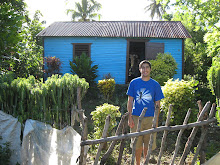
jueves, 23 de julio de 2009
Cooking and Improving Lives

Just because I’m not an environment or health Volunteer doesn’t mean I can’t do evironment or health-related work. Which is why I am now in the middle of the biggest project of my Peace Corps service.
About a year ago, I floated the idea of a wood-burning stove-building project, one of the central themes of the environment sector. What most people in the campo cook on is called a fogón – three large stones or cinderblocks as three sides to a square, set upon a table. The fourth side is left open in which to put firewood. Above the stones/bricks usually sits a length of rebar to complete the square on which to sit a large pot. These fogones are usually situated in poorly ventilated outdoor kitchens, which can fill with smoke during cooking. The stoves that are built as part of the project have an interior area to insert the firewood so as to increase efficiency (meaning that the heat produced by the burning firewood does not escape into the air but is directed into the cooking pots); these stoves also use considerably less firewood. The stoves also include a key addition: a chimney. The smoke is pulled up through the chimney and let out into the air above the kitchen. Those cooking (almost always women) therefore do not have to worry about various smoke-related problems, such as lung and eye irritations. Of course, the more the family uses this stove, the less they use the stovetop, which many families have, and thus don’t have to purchase the cooking gas.
The stoves intrigued my community partners and neighbors. We wrote a grant proposal and six long months later I received a check for $124,875 Dominican pesos, or about $3658 through SPA, or Small Project Assistance, grant available to Peace Corps Volunteers. I received the check in May, and immediately began working on the project. I opened a bank account, spent time at the hardware store, and talked to families interested in participating. One of the points I stressed in this project was that the stove was not a handout – I required each family to pay RD$800 towards the project, which mostly went to the labor. The family also had to provide breakfast and lunch, as well as someone to help the stove-builders, as well as attend a stove use and maintenance meeting. Before beginning construction, I hired a woman who builds these stoves professionally to come to my community to teach my abañil (mason) how to make the stove. He now is an expert himself.
By my modest measures, the project is a success. Through today, I have built 18, and have eight more to go. There were many more families who wanted to participate than there were stoves I could build under my budget. People from surrounding campos, and even the pueblo, hear of the project and have come to see these fascinating stoves for themselves. It is always nice to hear people tell me that I will be remembered for bringing such a wonderful project to Las Aromas. Although this is nice, I never really wanted to be a construction volunteer – the stereotypical American or foreign aid worker dropping in, building something, and leaving. I won’t be remembered for courses I taught to the youth, or attitudes I might have changed, but because 26 homes will have three-feet-cubed cinderblock boxes in their homes on which the families boil dinner. Such is the nature of the Volunteer experience. Even if in ten years I am only remembered as the American who lived in a tiny village for two years and built some stoves, at least I know I helped a few women live healthier lives, which they could then better use to improve the lives of their children and families.
Suscribirse a:
Comentarios (Atom)

